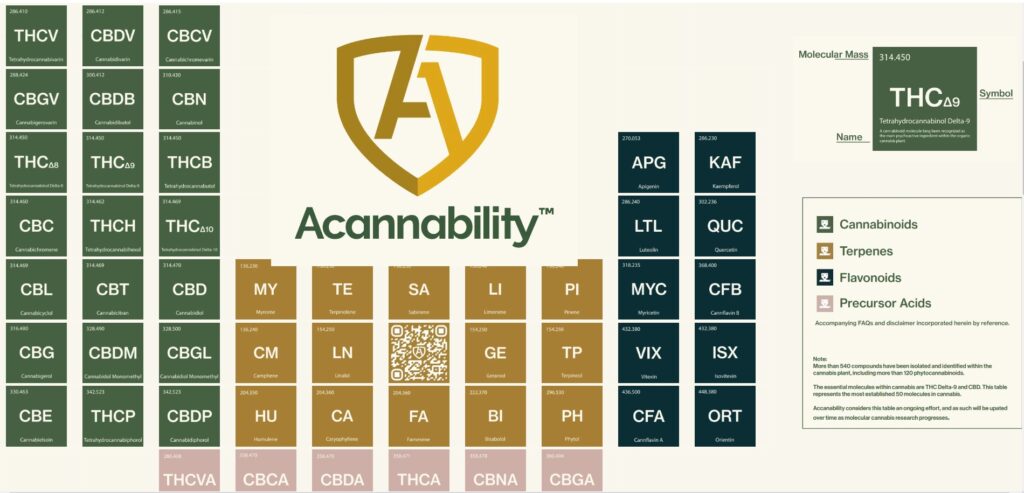The world of cannabis contains hundreds of chemical compounds, each with its specific properties and potential benefits. To make sense of this complex landscape, a new comprehensive resource has emerged – a periodic table-style chart that categorizes and simplifies the information related to cannabis components, making it accessible and understandable for everyone interested in the study and applications of marijuana.
What is the Comprehensive Cannabis Table?
Mirroring the format of the conventional periodic table used to catalog elements, this innovative chart sorts the various cannabis compounds into distinct sections using color-coding based on their type – cannabinoids, terpenes, flavonoids, and precursor acids. Furthermore, essential details like symbols, formulas, molecular mass, and brief descriptions are provided for every compound listed, producing an all-inclusive guide to the constituents present in cannabis plants.
Joseph Friedman: The Mind Behind the Cannabis Table
Joseph Friedman, a pharmacist with expertise in pharmacology and a consultant for Acannability, created this groundbreaking classification tool. As a founding member of the Professional Dispensaries of Illinois Medical LLC dispensary network, Friedman offers his experienced perspective on the increasingly important role that understanding cannabis compounds plays in advancing both scientific research and industry practices.
Friedman’s Comprehensive Cannabis Table has the potential to become an indispensable asset not only for professionals working in laboratories, dispensaries, and medical institutions but also for scholars and even everyday enthusiasts who wish to deepen their knowledge about the plant.
Organized Information for Enhanced Learning
Among the key strengths of the Cannabis Table is its ability to compile complex data in a streamlined and user-friendly visual representation. By imitating the structure of the conventional periodic table, it leverages familiarity, allowing users to navigate the chart and quickly locate essential information intuitively. This design choice makes the learning process seamless and efficient, enabling both experts and laypersons to absorb critical insights into cannabis compounds more effectively.
Understanding the Four Types: Cannabinoids, Terpenes, Flavonoids, Precursor Acids
The Cannabis Table breaks down compounds found in marijuana plants into four primary categories, giving users a clear framework for understanding how the components interact with each other and their potential effects on human health.

Cannabinoids
These are the most well-known compounds found in cannabis plants. The two most notable cannabinoids are tetrahydrocannabinol (THC) – primarily responsible for the psychoactive effects of marijuana use – and cannabidiol (CBD), which has become known for its therapeutic potential, such as relieving pain, inflammation, and anxiety. However, there are over 100 different cannabinoids present in this versatile plant.
Terpenes
These organic compounds contribute significantly to marijuana’s distinctive aroma and flavor profiles. Moreover, terpenes provide various therapeutic benefits, from promoting relaxation and reducing inflammation to enhancing memory and focus. Understanding individual terpenes can help people pinpoint specific cannabis strains that would best suit their health needs.
Flavonoids
Responsible for the bright pigmentation seen in many plants, flavonoids carry antioxidant properties that may help protect cells from damage caused by free radicals. Some research suggests that flavonoids unique to cannabis called cannaflavins might have potential anti-inflammatory effects, though further studies are needed to understand their full impact.
Precursor Acids
Cannabinoids and terpenes originate from precursor acids found in raw, living cannabis plants. Understanding the conversion of these acids into active compounds can help inform methods of consumption and potential health benefits associated with marijuana use.
A Revolutionary Tool for Cannabis Education
Joseph Friedman’s Comprehensive Cannabis Table offers an unprecedented resource for understanding the intricate world of cannabis compounds. By organizing vast amounts of complex information into a user-friendly format, this table can foster better education and informed decision-making surrounding the consumption and applications of marijuana, benefiting everyone from scientists to dispensary owners to everyday users.





